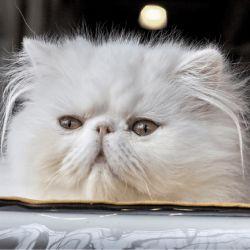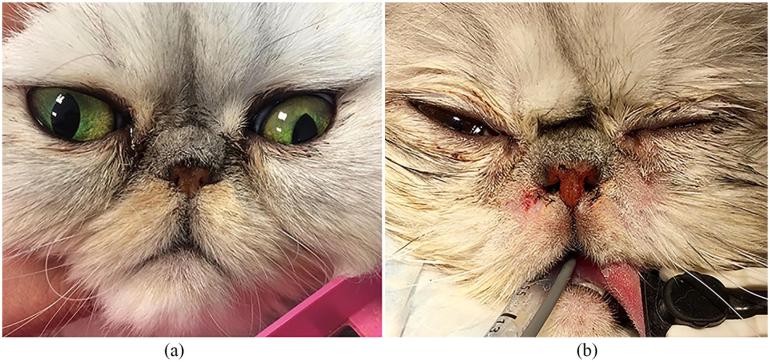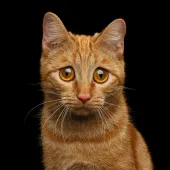Brachycephalic Upper Airway Obstruction Syndrome in Cats: Understanding the Challenges and Providing Care

Brachycephalic upper airway obstruction syndrome
Humans have created a vast array of distinct cat breeds over the course of the last century. Unfortunately, this has led to an increase in health issues among cats as a result of the high conformation of some of these breeds. Many pets now present with more severe manifestations of several congenital disorders at a much younger age, as a result of the ongoing enhanced selection pressure for 'desirable' physical qualities.
Breeds of cats and dogs with brachycephalic heads are one example. If you are thinking about purchasing or currently own a cat with a short nose, such as a Scottish fold, Persian, Himalayan, or exotic shorthair cat, you should be informed on the welfare concerns related to brachycephalic upper airway obstruction syndrome (BUAOS).
When viewed from the side, the most severely affected animals have the flattest faces, and their noses are not normally positioned deep below the eyes; instead, they are higher up, level with the eyes. These Persian cats could be referred to as "ultras," "peke-faced," or "extreme" varieties. The "tradition-type" Persians are those who have longer noses and are probably healthier.
What is brachycephalic upper airway syndrome?
Breeds with brachycephalic heads are more likely to have congenital anatomical anomalies that cause brachycephalic upper airway syndrome, or BUAOS. Cat breeds that have short noses, like as Persians and their related Himalayan and exotic shorthair types, are known as brachycephalic breeds. The soft tissue in the nose and throat of animals with shortened noses is still present, but it is compressed into a smaller area, folded up, and obstructs the airways. Animals with BUAOS may have one or more of the following defects:
- Excessively long and thickened soft palate.
- Narrowed laryngeal (voice box) due to protruding laryngeal saccules.
- Collapsed larynx (voice box).
- Stenotic (narrow) nares (nostrils).
- Narrow trachea (windpipe).
These cats' aberrant anatomical shape obstructs airflow via their airways. Breathing makes noise and makes it difficult to take in enough oxygen, particularly during greater oxygen needs like during exercise. The swelling of the throat and nose tissues brought on by hot weather exacerbates symptoms by obstructing airflow.
How would I know if my cat has BUAOS?
Symptoms
-
Loud Breathing: Cats with BUAOS often exhibit loud, noisy breathing, especially during physical activities or in warm weather when their breathing becomes more labored.
-
Snoring: Chronic snoring, both during sleep and awake periods, is a common symptom of BUAOS.
-
Exercise Intolerance: Affected cats may show reluctance to engage in physical activities due to the difficulty in breathing, leading to decreased exercise tolerance.
-
Open-Mouth Breathing: Cats might resort to breathing through their mouths, a sign of severe respiratory distress.
-
Gagging and Vomiting: Cats with BUAOS may gag or retch, particularly after eating or drinking, due to the effort of breathing and swallowing.
Cats that are severely affected may exhibit respiratory issues as early as 4-6 months of age, but most cats will display symptoms between 1-3 years of age. Your cat may snore loudly while sleeping or have noisy breathing as the first indications that it has BUAOS. In fact, a lot of cat owners with short noses believe that their pets' snoring and sniffling is typical. But these sounds mean that their pet's breathing is already becoming harder due to restricted airways. Cats with BUAOS usually have severe sleep disturbances because their airways block whenever they lie down or unwind.
Because many cats with BUAOS are unable or unable to exercise regularly, they are more likely to gain weight, which makes their issues worse. Breathing problems might suddenly worsen, resulting in respiratory distress or even a sudden collapse (especially in hot conditions). Exercise and excitement may be the cause of this decline. Animals that are severely afflicted may experience practically complete obstruction of their airways, develop a buildup of fluid in their lungs, and pass quite quickly if emergency veterinary care is not received.
How would my vet know if my cat has BUAOS?
The diagnosis is based on the clinical indicators (as well as the characteristic breed); nevertheless, additional testing may be necessary to validate the diagnosis, assess the severity of each component of BUAOS, and rule out other medical problems. In the event that your veterinarian detects BUAOS, they will want to examine the upper airway thoroughly while your cat is sedated.
They may also insert an endoscope—a tiny camera—through your cat's airways to see which abnormalities are there and how serious they are. For simultaneous therapy, it is best for these examinations to be conducted by a veterinary surgeon skilled in treating this problem. Unless the narrowings and tissue excesses have been treated, waking up after anesthesia is the most dangerous time for your pet. Anaesthesia and inspection without correction cause needless risk.
What other problems are associated with BUAOS?
BUAOS can lead to various complications, including heat intolerance, respiratory distress, and an increased risk of anesthesia-related problems during veterinary procedures.
Brachycephalic cats also have huge, projecting eyes that are either unable to close properly or have large eyelids. These eyes are prone to drying out, leaving the surface devoid of a tear coating for protection. This results in ocular sequestrum, ulcers, and injuries.
Because of the impacted tear drainage, there are additional issues. Tears from the inside corner of the eyelids normally drain into the nose through the nasolacrimal duct. This duct is a regular length in brachycephalic animals, although its location in the nose is small. As a result, the duct is squished and cannot function correctly. Tears pool up again and spill into the area of skin behind the eyes. This area develops painful, easily infected skin. We refer to this as epiphora. Additionally, the skin may be too thick and folded, and these folds themselves are prone to infection.
In addition to having difficulties giving birth, cats with BUAOS are also more likely to require a Caesarean section, which has a higher risk of death during the procedure.
Can BUAOS be treated?
Treatment options may include:
-
Surgical Correction: In severe cases, surgical procedures, such as soft palate resection and widening of the nares, can alleviate airway obstruction and significantly improve breathing.
-
Weight Management: Maintaining a healthy weight is crucial, as excess weight can worsen respiratory difficulties.
-
Avoiding Stress and Overexertion: Cats with BUAOS should be kept in a stress-free environment and not overexerted, especially in hot weather.
-
Regular Veterinary Check-ups: Cats with BUAOS require regular veterinary monitoring to assess their respiratory status and overall health.
A diet plan is an essential component of any care for overweight cats because the majority of BUAOS symptoms will improve if the animal sheds weight. Correcting the underlying abnormalities is the only approach to address BUAOS since it is caused by congenital abnormalities of the airways.
During surgery, the nostrils can be opened, and extra tissue that is obstructing the airways can be removed. Surgical correction is risky and demands a high level of competence. Your veterinarian might decide to recommend that you receive care from a surgeon and anesthetist who specialize in these treatments. The afflicted animals should have far better lives after surgery.
Early correction of the reversible underlying defects can delay or even stop the occurrence of additional irreversible changes that could further damage the airway. This highlights the significance of assessing your pet's respiratory health seriously at an early age and consulting a professional.

Is there a way of preventing this disease?
Preventing BUAOS involves responsible breeding practices. Ethical breeders should avoid mating cats with extreme brachycephalic features to reduce the risk of passing down airway abnormalities to their offspring.
Even if an animal has had surgery, it is crucial to avoid breeding with them because the problem is inherited and will impact the progeny as well. Sadly, the majority of show animals in the impacted breeds have been purposefully developed to exhibit the outward features that emerge from these problems (like a very short nose and flat face), therefore all animals in the breed have some degree of these flaws.
In the end, brachycephalic breeds are particularly vulnerable to BUAOS; some animals may experience breathing difficulties for years, similar to those experienced by people who are out of breath from exertion or a severe cold. The only way to stop this is for breeders to acknowledge that extreme conformations—like very small noses—are undesirable in cats.
See your veterinarian for advice if you have any concerns about your pet, particularly if it seems to be having respiratory issues.
Conclusion
Brachycephalic Upper Airway Obstruction Syndrome is a significant concern for certain cat breeds. Cat owners and breeders must be aware of the signs and symptoms associated with BUAOS to ensure affected cats receive appropriate care and interventions. Early recognition, veterinary consultation, and responsible breeding practices are essential steps toward improving the quality of life for brachycephalic cats affected by this syndrome.


